
The Solar-Terrestrial Centre of Excellence (STCE) is a collaborative network of the Belgian Institute for Space Aeronomy, the Royal Observatory of Belgium and the Royal Meteorological Institute of Belgium.
 |
Published by the STCE - this issue : 30 Jan 2015. The Solar-Terrestrial Centre of Excellence (STCE) is a collaborative network of the Belgian Institute for Space Aeronomy, the Royal Observatory of Belgium and the Royal Meteorological Institute of Belgium. |
| Archive of the newsletters | Subscribe to this newsletter by mail |
Over the last few weeks, sky gazers have been enjoying a relatively bright and colorful comet in the northern skies. Comet Lovejoy, named after its discoverer Terry Lovejoy (Australia), has been the source of many beautiful pictures that can be admired on the web (see e.g. Spaceweather.com comet gallery at http://spaceweathergallery.com/comet_gallery.html).
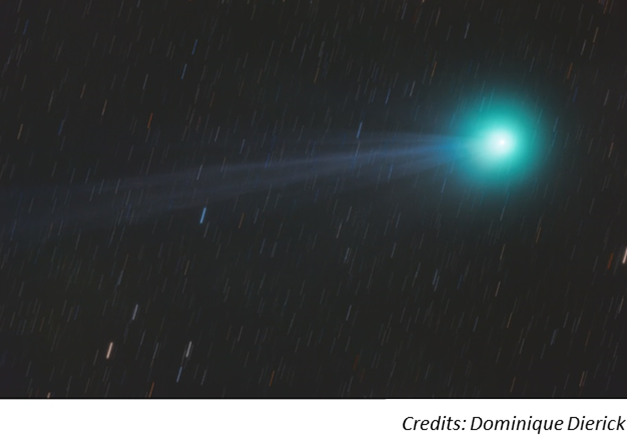
The comet was closest to Earth on 7 January, passing above the ecliptic (the Sun-Earth plane) 2 days later which resulted in better viewing conditions for observers on the northern hemisphere. At the time, the comet was at a distance of about 200 million kilometers from the Sun (see diagram below). Many observers reported it even visible to the naked eye.
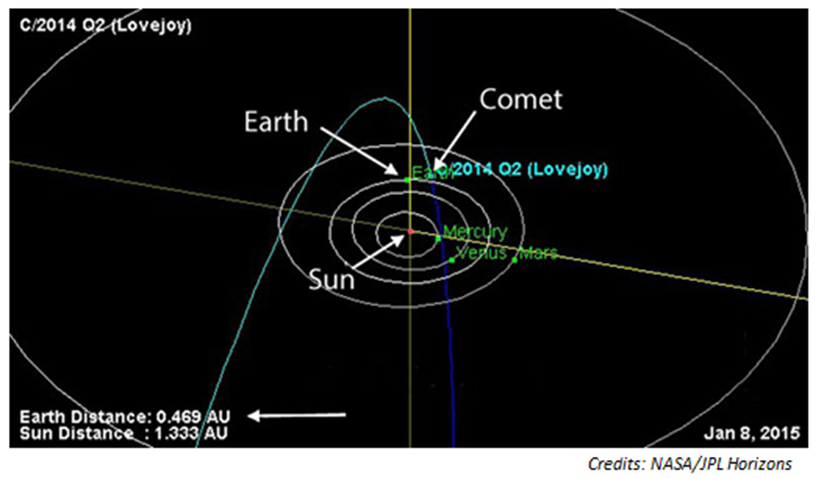
Interestingly, on 8 January, an abrupt change in the comet's ion tail could be observed. An ion tail forms when ultraviolet sunlight rips one or more electrons from gas atoms in the particle cloud around the comet's nucleus, turning them into ions (charged particles). The solar wind then carries these ions straight outward and away from the Sun along the magnetic field lines that are draped around the comet. This is why an ion tail is always pointing away from the Sun. Hence, it is no surprise that when there is a sufficiently strong disturbance in the solar wind, this tail can get detached from the comet. This is called a disconnection event (DE). Such a disconnection event occurred on 8 January (see annotated images below).
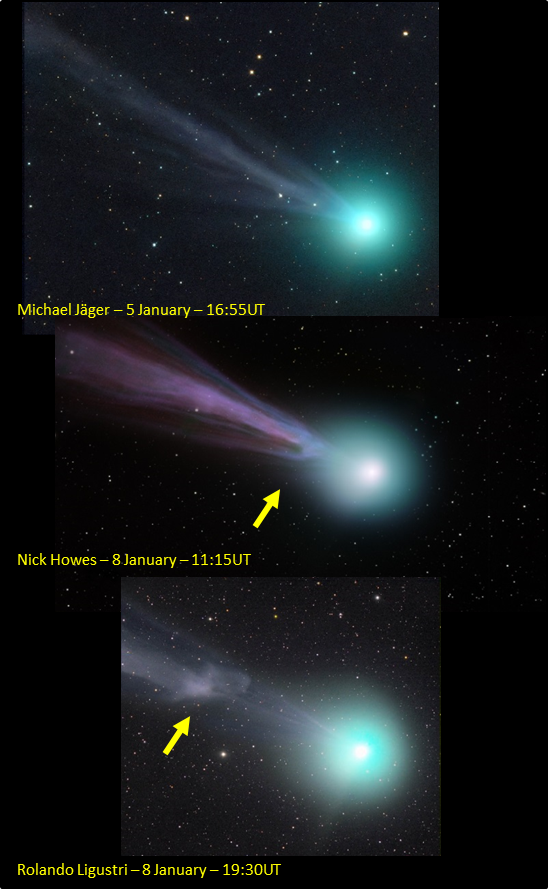
The intriguing question is if we can trace back the source of the perturbation in the solar wind. As it turns out, the culprit might have been the same curious, strong disturbance that created a major geomagnetic storm on 7 January at Earth (see this news item at http://stce.be/news/290/welcome.html). Indeed, the comet was more or less in the same pathway of the disturbance as the Earth (see the diagram above). At the observed speed of 480-500 km/s at Earth, it would take about 28-30 hours for the solar wind to transit the remaining 50 million kilometers to the comet. This would put the timing of the encounter of the disturbance with the comet somewhere between 08:00 and 09:00UT on 8 January, nicely fitting Nick Howes 11:15UT image, taken just after the DE had started. The magnetic field of the disturbance had also enough enough punch to detach the comet's tail. Its magnetic field was twice as strong than that of passing high speed streams from coronal holes (e.g. a component of resp. 20 nT vs. 10 nT). See the annotated diagram underneath.

Credits: The original images of the comet can be found at the Spaceweather.com comet gallery (http://spaceweathergallery.com/comet_gallery.html):
- Michael Jäger (http://spaceweathergallery.com/indiv_upload.php?upload_id=106346);
- Nick Howes (http://spaceweathergallery.com/indiv_upload.php?upload_id=106566);
- Rolando Ligustri (http://spaceweathergallery.com/indiv_upload.php?upload_id=106529).
Solar flare activity fluctuated between low and moderate during the week.
In order to view the activity of this week in more detail, we suggest to go to the following website from which all the daily (normal and difference) movies can be accessed:http://proba2.oma.be/ssa
This page also lists the recorded flaring events.
A weekly overview movie can be found here (SWAP week 252).
http://proba2.oma.be/swap/data/mpg/movies/weekly_movies/weekly_movie_2015_01_19.mp4
Details about some of this week's events, can be found further below.
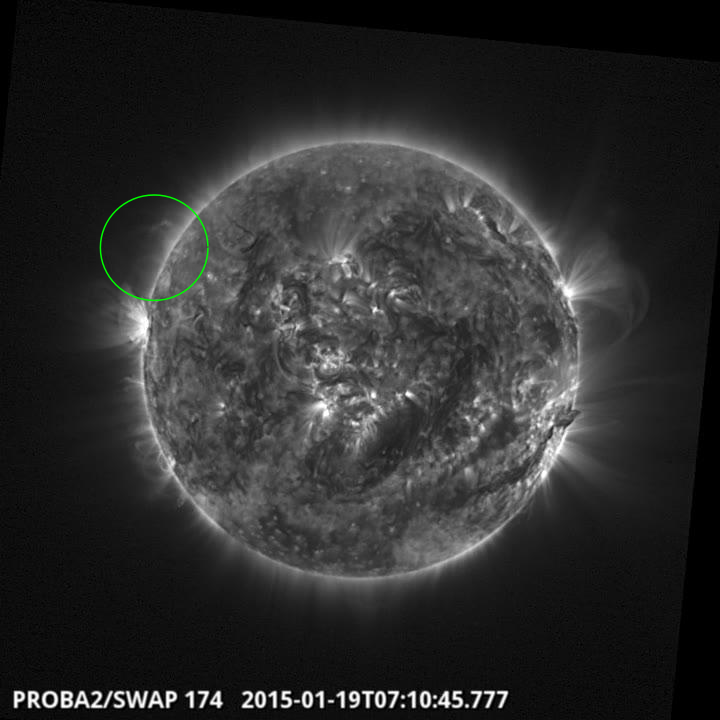
Eruption north east limb @ 07:10 SWAP image
Find a movie of the events here (SWAP movie)
http://proba2.oma.be/swap/data/mpg/movies/20150119_swap_movie.mp4

Eruption north west limb @ 02:31 SWAP image
Find a movie of the events here (SWAP movie)
http://proba2.oma.be/swap/data/mpg/movies/20150120_swap_movie.mp4
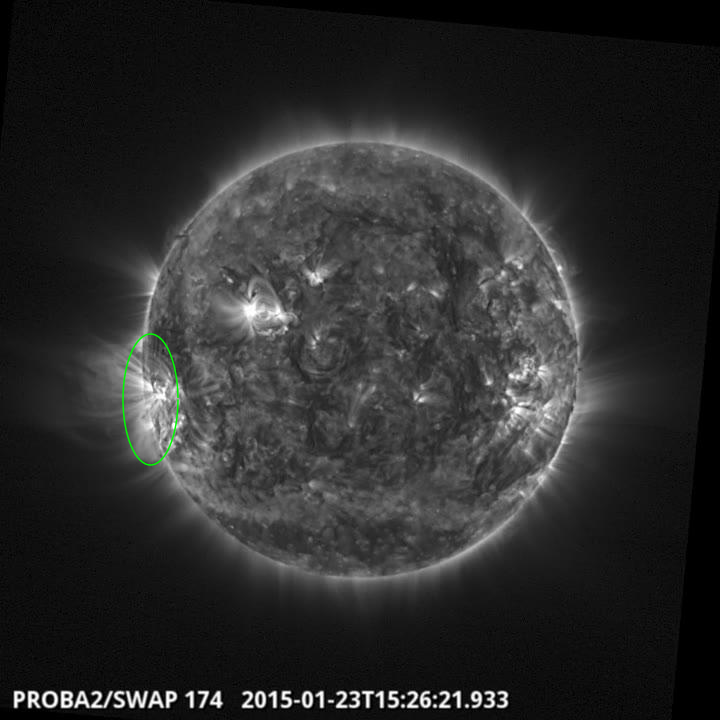
Filament restructuring on the east limb @ 15:26 SWAP image
Find a movie of the event here (SWAP movie)
http://proba2.oma.be/swap/data/mpg/movies/20150123_swap_movie.mp4
Solar activity at the beginning of the week was very low with only minor C-class flaring. The activity increased with the appearance of NOAA AR 2268 over the east limb producing several C-class flares and one M1.4 flare on January 22, with peak at 04:52 UT.
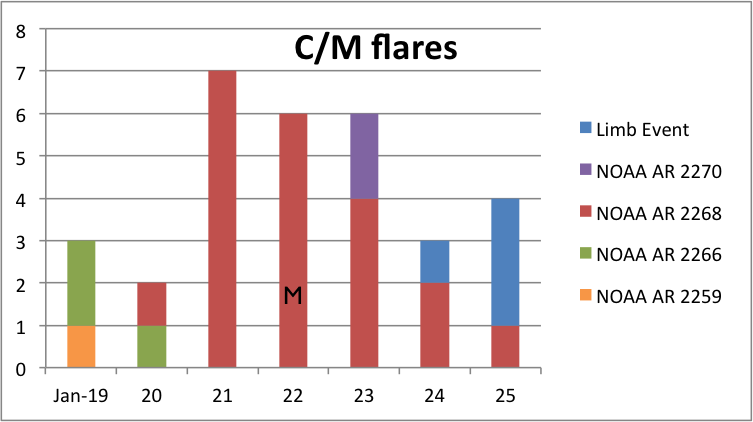
A slow partial halo CME mostly directed to the south, was seen at 15:48 UT on January 24 from a filament eruption close to disk center.
The fast speed stream from a coronal hole (below: SDO/AIA on January 17, red oval) arrived to the Earth on January 21, raising geomagnetic conditions to active levels during the night of January 21 to 22. The rest of the week was at quiet to unsettled levels.
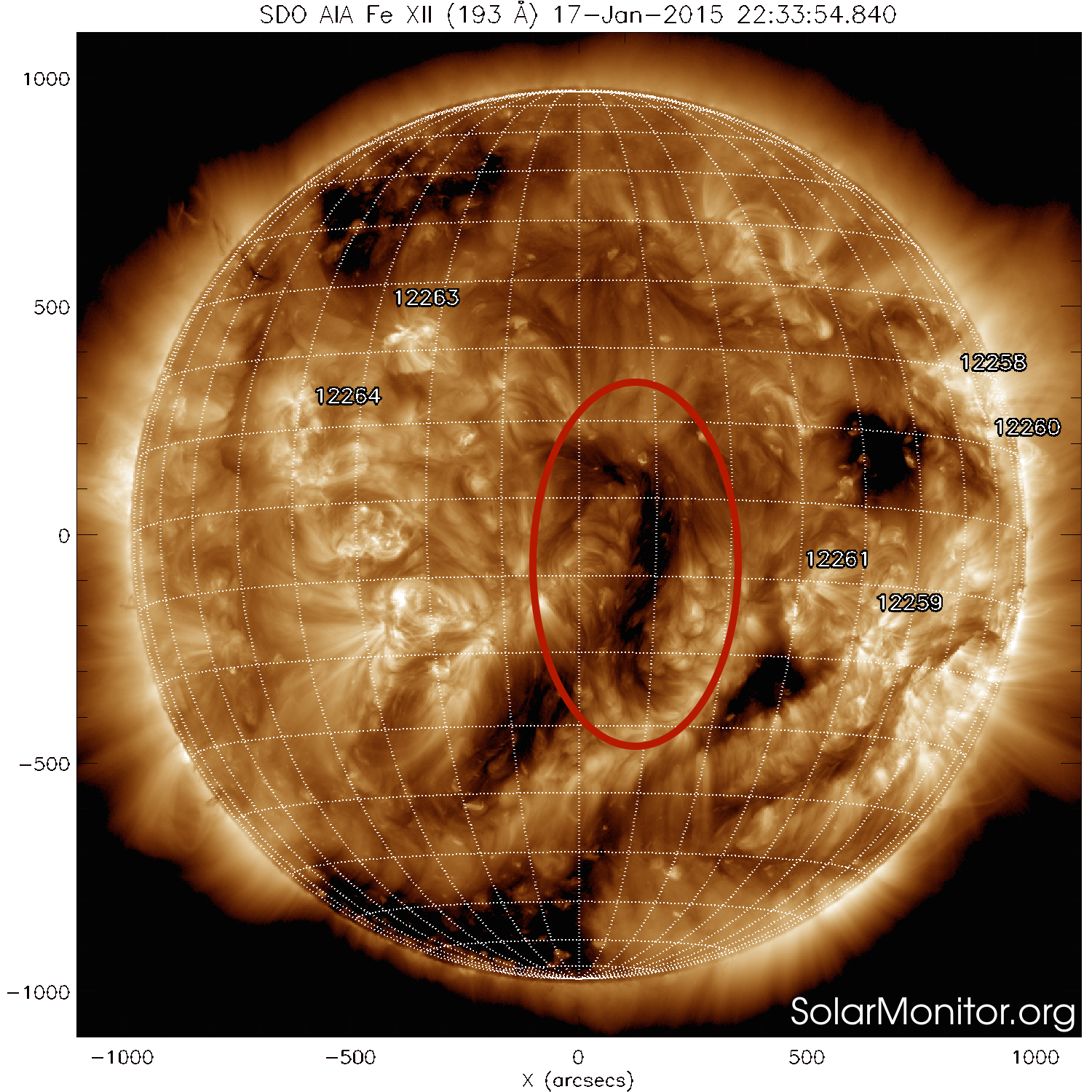
ACE data show the co-rotating interaction region (CIR°) with increased density and magnetic field and the fast solar wind.
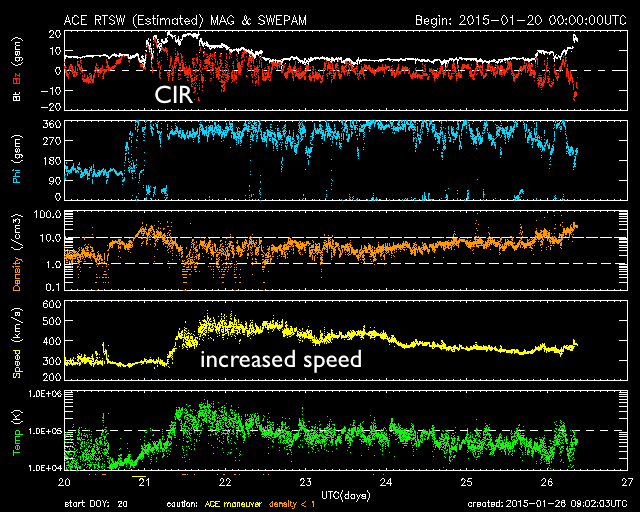
Although the CME from January 24 was mostly directed to the south, a part of it may hit the Earth on January 29. Due to the southward direction and the low speed, the January 24 CME did not arrive.
| DAY | BEGIN | MAX | END | LOC | XRAY | OP | 10CM | TYPE | Cat | NOAA |
| 22 | 0443 | 0452 | 0502 | M1.4 | 2268 |
| LOC: approximate heliographic location | TYPE: radio burst type |
| XRAY: X-ray flare class | Cat: Catania sunspot group number |
| OP: optical flare class | NOAA: NOAA active region number |
| 10CM: peak 10 cm radio flux |
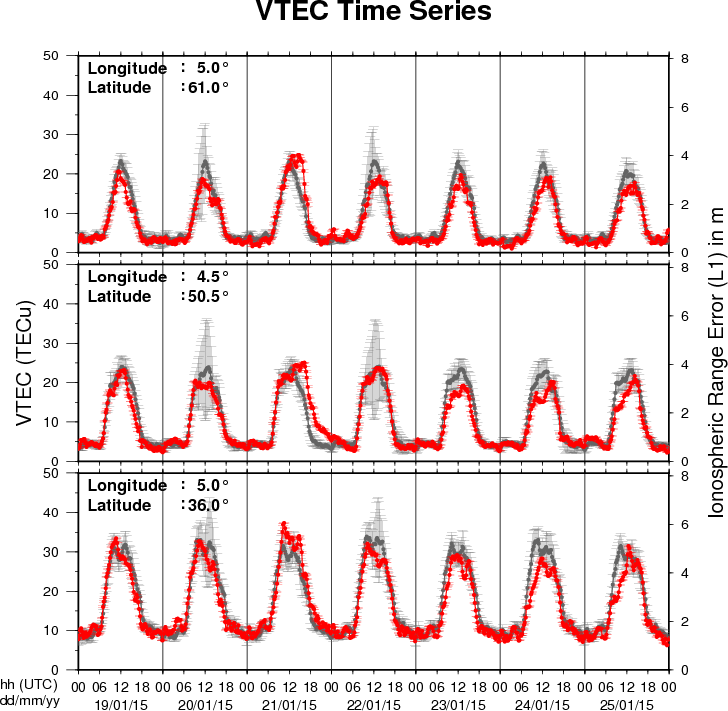
The figure shows the time evolution of the Vertical Total Electron Content (VTEC) (in red) during the last week at three locations:
a) in the northern part of Europe(N61°, 5°E)
b) above Brussels(N50.5°, 4.5°E)
c) in the southern part of Europe(N36°, 5°E)
This figure also shows (in grey) the normal ionospheric behaviour expected based on the median VTEC from the 15 previous days.
The VTEC is expressed in TECu (with TECu=10^16 electrons per square meter) and is directly related to the signal propagation delay due to the ionosphere (in figure: delay on GPS L1 frequency).
The Sun's radiation ionizes the Earth's upper atmosphere, the ionosphere, located from about 60km to 1000km above the Earth's surface.The ionization process in the ionosphere produces ions and free electrons. These electrons perturb the propagation of the GNSS (Global Navigation Satellite System) signals by inducing a so-called ionospheric delay.
See http://stce.be/newsletter/GNSS_final.pdf for some more explanations ; for detailed information, see http://gnss.be/ionosphere_tutorial.php
Start : 2015-03-16 - End : 2015-03-19
This international conference will provide an overview of our
current understanding of Sun-Climate Connections starting at
processes on the Sun itself over space weather and solar wind
towards solar influence on the upper atmosphere down to the ocean.
It will also provide insights into the heatedly debated role of the
Sun in climate change. In four sessions the various contributions
of solar variability influence on Earth's climate will be presented
and discussed by bringing together solar physicists, space
scientists, atmospheric scientists, climate modellers, and
paleoclimatologists.
We expect contributions from scientists participating in
SCOSTEP/ROSMIC, SPARC-SOLARIS/HEPPA, the EU cost network TOSCA, as
well as any other interested scientists. The conference will last
three full days, beginning Monday morning, 16 March 2013. The
programme will consist of invited and keynote lectures, a few
contributed oral presentations and ample time dedicated to poster
sessions. The fourth day will be devoted to public outreach
activities as well as panel discussions.
Website: http://scc.geomar.de/
Start : 2015-05-18 - End : 2015-05-22
URSI AT-RASC 2015 will be the first edition of the newly
established triennial URSI Atlantic Radio Science Conference as one
of the URSI Flagship Conferences. AT-RASC 2015 will have an open
scientific program composed of submitted papers within the domains
covered by all ten Commissions of URSI.
Website: http://www.at-rasc.com/
Start : 2015-06-01 - End : 2015-07-24
The Space Weather Summer School at Los Alamos National
Laboratory, established in 2011 under the founding Director Josef
Koller, is dedicated to space weather, space science and
applications. Every year we solicit applications for the Los Alamos
Space Weather Summer School. This summer school is sponsored and
supported by a number or organizations at LANL. This year our top
sponsors include the Los Alamos Institute of Geophysics, Planetary
Physics and Signatures (IGPPS) and the Laboratory Directed Research
and Development Office (LDRD). The summer school brings together
top space science students with internationally recognized
researchers at LANL in an educational and collaborative
atmosphere.
Website:
http://www.swx-school.lanl.gov/
Start : 2015-07-21 - End : 2015-07-23
The conference will review past and recent achievements, as well
as future challenges in the field of solar coronal loop
physics.
Website:
http://www.damtp.cam.ac.uk/user/astro/cl7/index.html
Start : 2015-07-28 - End : 2015-08-04
Heliophysics is all of the science common to the field of the
Sun-Earth connections. This fast-developing field of research
covers many traditional sub-disciplines of space physics,
astrophysics, and climate studies. The NASA Living with a Star
program, with its focus on the basic science underlying all aspects
of space weather, acts as a catalyst to bring the many research
disciplines together to deepen our understanding of the system of
systems formed by the Sun-Earth connection.
Website:
http://www.heliophysics.ucar.edu/
Start : 2015-07-30 - End : 2015-08-06
The 34th International Cosmic Ray Conference (ICRC) will be held
from July 30 to August 6, 2015, in The Hague, The Netherlands. It
is an important and large conference in the field of Astroparticle
Physics. The ICRC covers: cosmic-ray physics, solar and
heliospheric physics, gamma-ray astronomy, neutrino astronomy, and
dark matter physics.
Website: http://icrc2015.nl
Start : 2015-10-05 - End : 2015-10-09
This CSPM-2015 scientific meeting will cover various aspects of
solar dynamic and magnetic phenomena which are observed over the
entire electromagnetic spectrum: white-light, Hα, Ca II,
and radio from ground and in a variety of other wavelengths (white
light, UV and EUV, and X-rays) from space. Emphasis will also be
placed on instrumentation, observing techniques, and solar image
processing techniques, as well as theory and modelling through
detailed radiative transfer in increasingly realistic MHD models.
The long-term (cyclic) evolution of solar magnetism and its
consequence for the solar atmosphere, eruptive phenomena, solar
irradiation variations, and space weather, will be in focus. Here,
special attention will be devoted to the long-term observations
made in Coimbra and also to the results of the SPRING / SOLARNET
and SCOSTEP VarSITI studies. In particular, the weak solar activity
during the current solar maximum will be discussed. Finally, since
this meeting is organised around the 90th anniversary of performing
the first spectroheliographic observations in Coimbra, a session
will be specially dedicated to new solar instruments (both
ground-based and space-borne) that will give access to unexplored
solar atmospheric features and dynamic phenomena over the coming
years.
Website:
http://www.mat.uc.pt/~cspm2015/
Start : 2016-07-30 - End : 2016-08-07
The 41st COSPAR Scientific Assembly will be held in Istanbul,
Turkey from 30 July - 7 August 2016. This Assembly is open to all
bona fide scientists.
Website:
https://www.cospar-assembly.org/